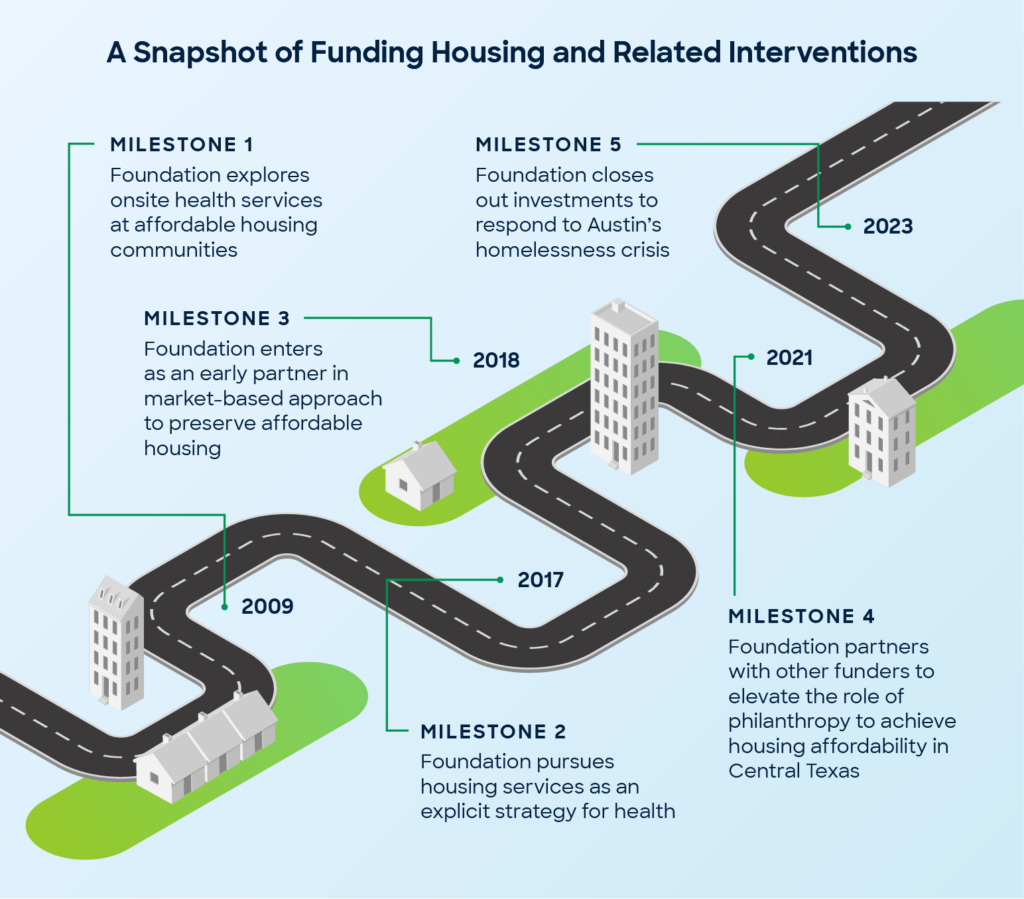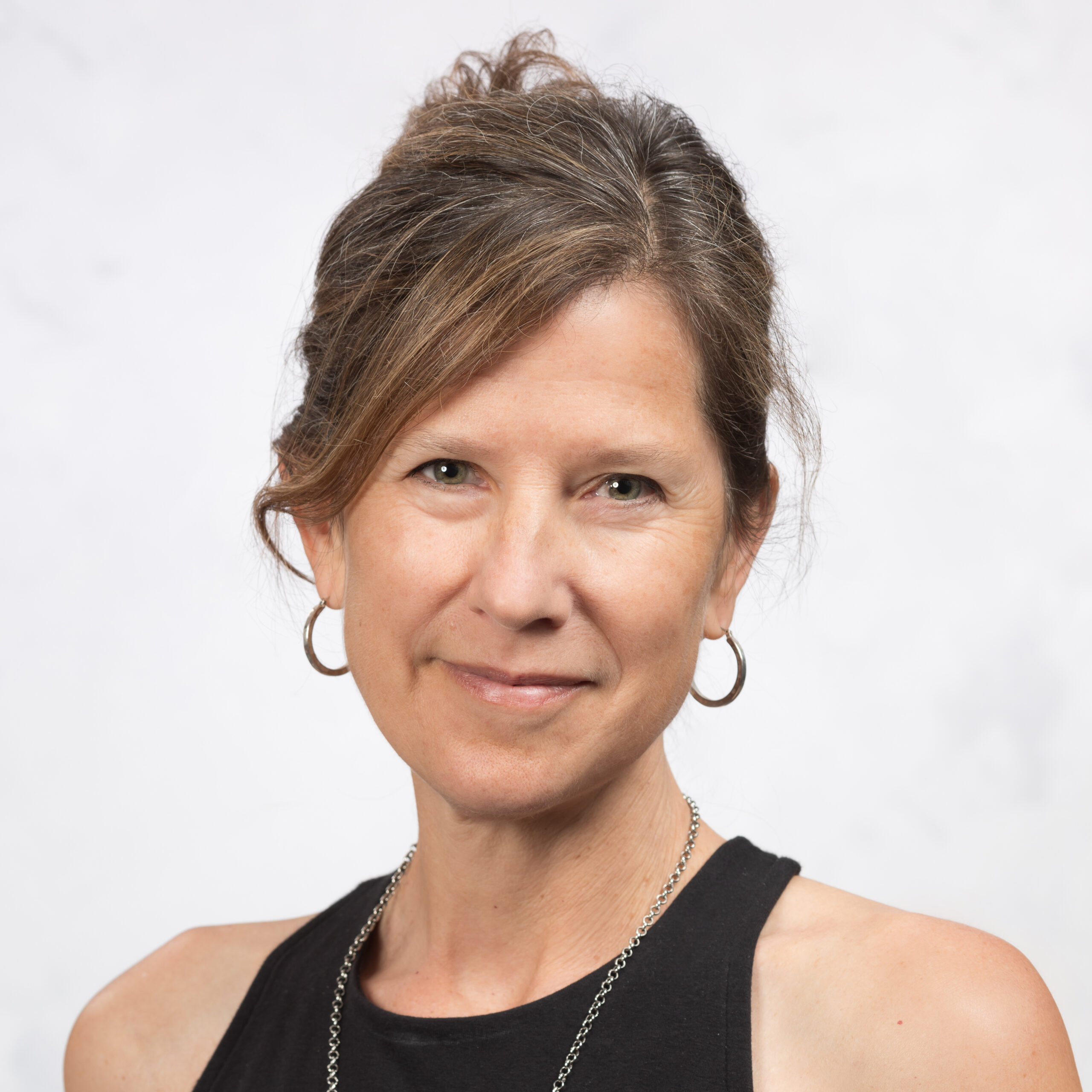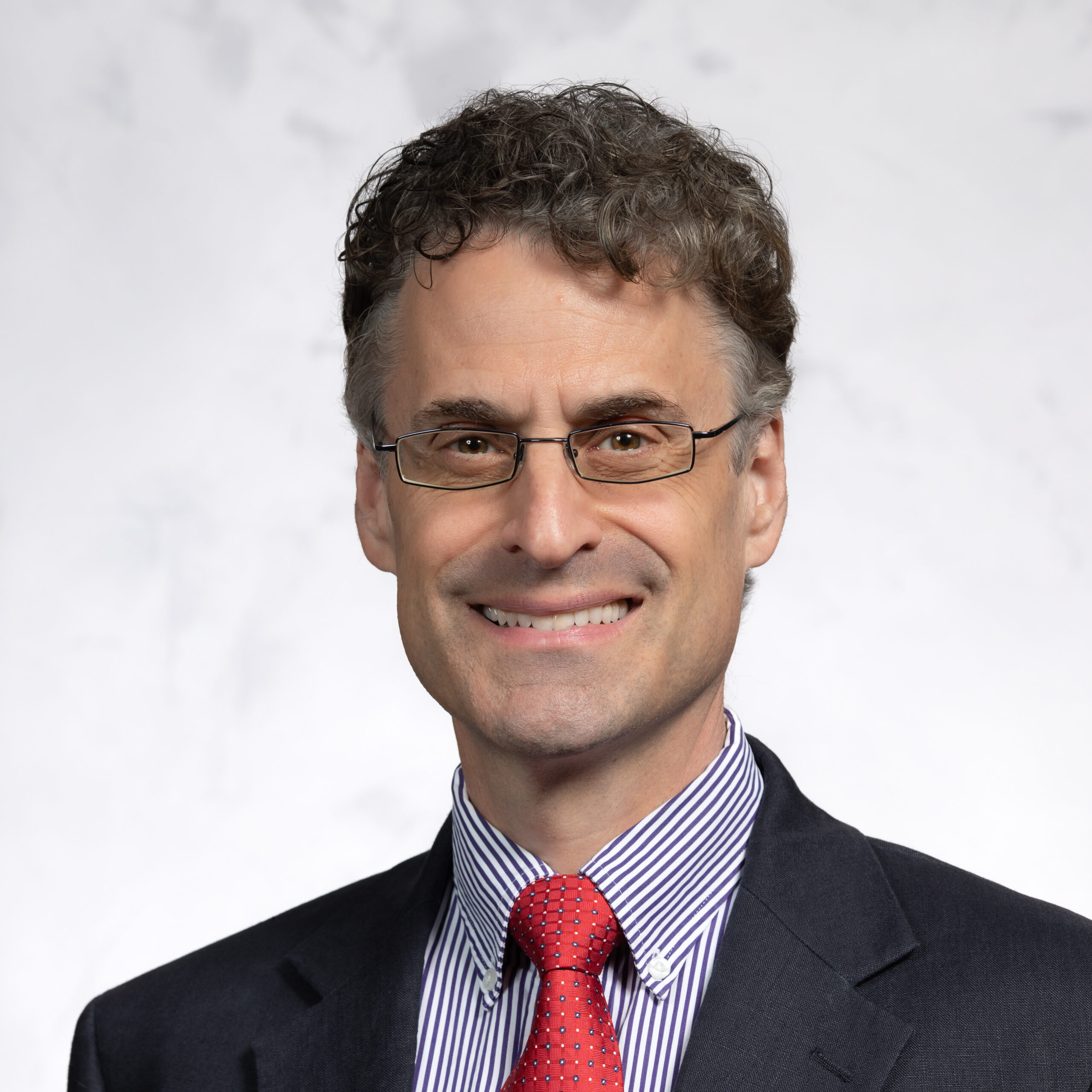Takeaway
St. David’s Foundation’s mission is to advance health equity through investment and action so that everyone has the opportunity to achieve optimal health. As our strategy to remove barriers and shift systems and conditions to improve health outcomes evolves, we recognize that access to safe and affordable housing often sits at the center of one’s ability to live a healthy life. Here we reflect on our past work and share our insights as we better understand our role and impact in the complex issue of housing.
According to our most recent Community Health Needs Assessment, lack of affordable housing is one of the top community conditions identified by Central Texans as impacting their health. However, whether the Foundation should play a role in helping Central Texans secure safe, stable, affordable housing has not always been clear, nor has the type of role we should play if we did engage in funding in this space.
As we grappled with developing an effective stance to housing in our work to advance health equity, we frequently came back to Dr. Megan Sandel’s description of the relationship of housing to health: “Housing acts like a vaccine – it provides multiple and long-lasting benefits for both individuals and society.” That’s the rub – housing might not be healthcare, but without safe, stable, affordable housing, individual and community health interventions, however strong, rarely achieve lasting outcomes. This truism is likely why housing is one of the most thoroughly researched non-medical driver of health, with a large body of evidence demonstrating how housing interventions, particularly for individuals and families with limited incomes, can improve health outcomes and decrease healthcare costs.
The Foundation’s Evolving Approach
Ongoing research and insights into the relationship between housing and health have influenced the Foundation’s approach, which has evolved significantly over the last two decades. We have shifted from viewing housing as outside of what we support as a health foundation to adopting an approach that acknowledges housing as a key driver of health outcomes and economic security. This evolution is shaped by the Foundation’s growing awareness of philanthropy’s potential to catalyze and contribute to sustainable solutions to pressing challenges, the health sector’s increasing understanding of nonmedical drivers of health, and our desire to identify the inequitable conditions that lock disparities in place.
Below, we offer key milestones on our journey to see housing as an essential platform for health, highlighting how and why our approach evolved.

Milestone 1: Foundation explores onsite health services at affordable housing communities (2009)
St. David’s Foundation’s first investment that explicitly acknowledged housing as a platform for health was a 2009 grant to test the impact of onsite psychiatric support to high need individuals living at Foundation Communities’ Garden Terrace property. The pilot found that embedding psychiatric and basic health supports where high need individuals live resulted in fewer adverse health outcomes, such as EMS calls (an effective metric to demonstrate both improved health outcomes for individuals as well as cost saving for taxpayers). Those findings provided compelling evidence to consider how the Foundation could expand support of the wrap-around services component of supportive housing. While housing was not a specific priority, the Foundation began funding health and health-related services delivered in both affordable and supportive housing communities.
Milestone 2: Foundation pursues housing services as an explicit strategy for health (2017)
Under the Foundation’s 2017–2019 strategic plan, housing wrap-around services were named as a mechanism to bring opportunity (i.e., learning centers, access to health services, and financial coaching) to low-income individuals. In developing the housing supports grantmaking focus area, the Foundation noted that the vast majority of subsidized housing was located in “low opportunity” zones (as defined by the Kirwan Institute). During this period, the Foundation released an RFP, Health Starts at Home: Expanding Housing Wrap-Around Services and Supports, where we sought to test ideas and build grantee capacity in approaches we believed could amplify impact, such as using a strengths-based focus, fostering social connection, and applying human-centered design principles to spaces and places where services occur. The RFP also provided an impetus for the Foundation to articulate its evolving thinking on the role of housing as a lever for health and to note the structural issues at play in Central Texas’ growing income inequality and the insufficient supply of affordable housing.
Milestone 3: Foundation enters as an early partner in market-based approach to preserve affordable housing (2018)
The Foundation was an early investor in the Austin Housing Conservancy, which tested the use of private, civic-minded capital to create a “housing strike fund” to preserve naturally occurring affordable housing in high opportunity locations. Working with this model highlighted the market forces that threaten naturally occurring affordable housing and the missing middle in a healthy housing ecosystem. Most importantly, this work prompted the Foundation to draw a clearer connection between the availability of safe, stable, affordable housing to health and other desired outcomes like educational success and workforce participation.
Milestone 4: Foundation partners with other funders to elevate the role of philanthropy to achieve housing affordability in Central Texas (2021)
In partnership with Austin Community Foundation and other local funders, the Foundation provided financial support and input to a 2021 report, Producing, Protecting and Preserving Housing Affordability in Central Texas, which identified a framework of affordable housing to create a healthy housing continuum and outlined specific recommendations for the role of philanthropy to help achieve these goals. Participating in the development and promotion of this report deepened the Foundation’s understanding of the forces at play in affordable housing and most importantly, prompted the Foundation to identify roles it could play beyond providing financial capital, including, when appropriate, our social, moral, and reputational capital.
Milestone 5: Foundation closes out investments to respond to Austin’s homelessness crisis (2023)
In response to Austin’s homelessness crisis, the Foundation’s Board made a commitment to this community need. Over the past three years, the Foundation made sizeable investments to increase local capacity to respond to family and individual homelessness, accelerate the pace of affordable housing production, and continue progress in system level improvements. These investments aligned with the community goal of making homelessness rare, brief, and non-recurring. This commitment, while outside of the Foundation’s strategy at that time and meant to be one-time in nature, helped to highlight the need for system level, coordinated solutions to complex issues such as homelessness and housing. This reinforced the idea that advancing health equity and prompting sustainable solutions to complex issues would require the Foundation to play a role beyond that of funder.
Key Takeaways
The Foundation has developed a strong appreciation for housing’s role as a platform for health and a deeper understanding of the associated political, market, and other structural issues that shape a region’s housing landscape. We have also gained insights into the role philanthropy can play in areas where singular programmatic investments are not sufficient to create sustainable solutions. In these complex challenges, we believe philanthropy can (and often should) act as more than just a funder, leaning into roles such as:
- Champion. System level solutions, while appealing, often require undertaking a different approach than current practice. As a result, there is often natural push-back and reluctance to embrace this work that often comes without a clear reward for the organizations and sectors pushing for those new improvements. Philanthropy can help socialize messages, amplify research, and champion the hard work needed for long-term solutions. Importantly, philanthropy is often well positioned to highlight community successes, which can be key to sustaining momentum.
- Convener & Connector. Important work often requires an invitation for cross– sector involvement and neutral spaces to wrestle with tough decisions. Philanthropy can issue these invitations and create the spaces for these discussions. Often this work is “behind the scenes” but a critical part of successful change efforts. In taking on these roles, philanthropy can help a community build some of the connective tissue necessary for community change.
- Catalyst. Unlike our colleagues in the service delivery sector who have urgent daily issues to address, or our peers in the public sector who must balance public expectations combined with the generally restricted nature of public funding, philanthropy has the ability to offer patient capital, stating hard truths without fear of losing our “seat,” or testing new ideas that might not work. If we can get more comfortable with an occasional misstep or failure, philanthropy can serve as a constructive catalyst in unlocking ideas that require some space and time to explore. We should be willing to provide the permission for community efforts to “effectively fail” a bit in service to finding a solid solution.
Conclusion
St. David’s Foundation’s has identified advancing health equity as central to our mission of ensuring that everyone has the opportunity to achieve optimal health. At an individual level, it is hard to live a healthy life without a safe, affordable place to call home. At a systems level, housing patterns can either help to reverse or hold in place many of the structural inequities we seek to end. It is no coincidence that most subsidized housing is located in areas with scant opportunity. The stamp of past discriminatory polices persists, dictating who lives where and who has access to what amenities. While the Foundation believes the potential of our neighbors is evenly distributed, we also know that their access to opportunity to live healthy lives is not. Bottom line: We have found it is nearly impossible to sidestep housing on a journey to true health equity.
None of this journey and the accompanying insights would have occurred without the leadership and hard day-to-day work of the nonprofit providers, advocates, and researchers who help us better understand this complex sector. To those individuals we express our gratitude for your work, your willingness to let us learn from you, and your patience as we evolved to an understanding that you knew early on. Our region has some of the most talented leaders in the housing sector. We are proud to fuel and support that tremendous talent.
Resources
- Comprehensive study on roots of homelessness. Kushel, M., Moore, T., et al. (2023). Toward a New Understanding: The California Statewide Study of People Experiencing Homelessness. UCSF Benioff Homelessness and Housing Initiative. A helpful discussion of this report can be found on the Ezra Klein July 18,2023 podcast.
- For information on the linkage between housing and health, see Housing and Health: An Overview Of The Literature, in Health Affairs, June 2018, available at: https://www.healthaffairs.org/do/10.1377/hpb20180313.396577/full/
- For more information on characteristics of place that promote health, see Back to Our Roots: Catalyzing Community Action for Mental Health and Wellbeing, the Prevention Institute, September 2017, available at: https://www.preventioninstitute.org/sites/default/files/publications/Back%20to%20Our%20Roots-Catalyzing%20%20Community%20Action%20for%20Mental%20Health%20and%20Wellbeing.pdf
- Housing as a Hub for Health, Community Services and Upward Mobility. Brookings. March 2018. https://www.brookings.edu/research/housing-as-a-hub-for-health-community-services-and-upward-mobility/
- The Gates Foundation made a 10-year commitment to ending family homelessness. Learnings and insights from that body of work is captured at: https://local.gatesfoundation.org/our-work/past-initiatives/
- Provocative SSIR article on how philanthropy can rethink how it invests: To End Homelessness, the Energy of Money Must Change. Available here: https://ssir.org/articles/entry/to_end_homelessness_the_energy_of_money_must_change#.
- Report commissioned by Austin Community Foundation, SDF and others other on philanthropy’s role in affordable housing. Producing, Protecting and Preserving Housing Affordability in Central Texas: Philanthropic Opportunities. Released 2022. Available at: https://www.austincf.org/wp-content/uploads/2021/05/HousingReport-web.pdf
- Austin’s Homelessness Response System Dashboard. Available at: https://www.austinecho.org/dashboard/

